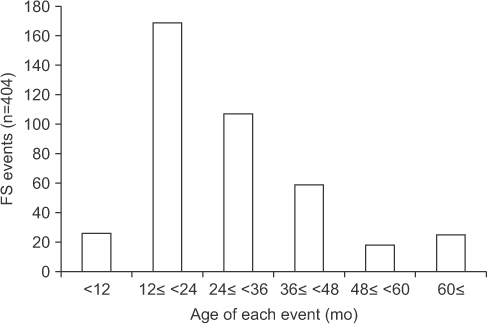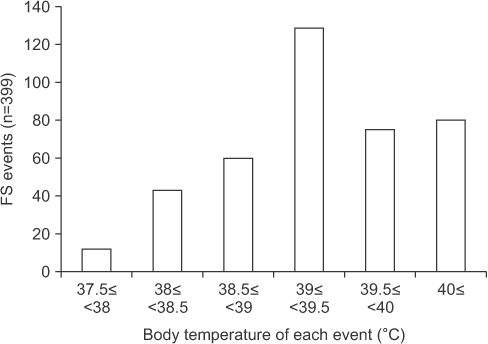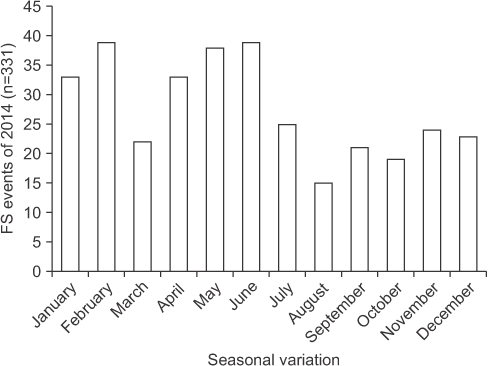Ewha Med J.
2017 Oct;40(4):149-154. 10.12771/emj.2017.40.4.149.
Current Clinical Features of Febrile Seizures in a Pediatric Emergency Room
- Affiliations
-
- 1Department of Pediatrics, Ewha Womans University College of Medicine, Seoul, Korea. acho@ewha.ac.kr
- KMID: 2393718
- DOI: http://doi.org/10.12771/emj.2017.40.4.149
Abstract
OBJECTIVES
To expand current knowledge on febrile seizures (FSs), the most common childhood seizure disorder, we investigated clinical features and risk factors of FS in the pediatric emergency department of a center in western Seoul.
METHODS
Children with FS that visited the pediatric emergency room of the Ewha Womans University Medical Center from January to December 2014 were included in this study. A retrospective medical record review was conducted for a total of 404 seizure events relative to 265 patients.
RESULTS
A total of 150 boys and 115 girls were enrolled. Children presenting their first FSs were 70.9% (n=188). Average age of FS onset was 28.9 months. Family history was reported in 95 children (36.8%) with higher relevance of paternal inheritance (44.2%, n=42/95). More than half of the seizures (56.4%, n=228/404) occurred on the first day of fever. The most common cause of fever was upper respiratory tract infection (65.8%, n=266/404). Children attending a daycare center had higher incidence of multiple FS compared to those cared for at home. Approximately one third of seizure events (31.7%, n=128/404) were admission cases, mainly because of prolonged fever.
CONCLUSION
FS is a common neurologic disorder with relatively high admission rate among pediatric emergency department visits. Daycare attendance is associated with current increased incidence of multiple FS. Further study with long-term follow up is necessary to expand knowledge on improving clinical care strategy in FS.
Keyword
MeSH Terms
Figure
Reference
-
1. Shinnar S, Glauser TA. Febrile seizures. J Child Neurol. 2002; 17:Suppl 1. S44–S52.2. Kim SH. Predictors of recurrent febrile seizure. J Korean Child Neurol Soc. 2014; 22:149–154.3. Nelson KB, Ellenberg JH. Prognosis in children with febrile seizures. Pediatrics. 1978; 61:720–727.4. Verity CM, Golding J. Risk of epilepsy after febrile convulsions: a national cohort study. BMJ. 1991; 303:1373–1376.5. Berg AT, Shinnar S, Hauser WA, Alemany M, Shapiro ED, Salomon ME, et al. A prospective study of recurrent febrile seizures. N Engl J Med. 1992; 327:1122–1127.6. Noh JH, Koh ID, Song KS, Cha BH. Clinical characteristics and risk factors of multiple recurrent febrile seizures among children. J Korean Child Neurol Soc. 2015; 23:7–12.7. Hong SA, Kim SH, Lee SL, Kim JS. Influencing factors on duration and frequency of febrile convulsion. J Korean Child Neurol Soc. 2002; 10:87–93.8. Hwang G, Kang HS, Park SY, Han KH, Kim SH. Predictors of unprovoked seizure after febrile seizure: short-term outcomes. Brain Dev. 2015; 37:315–321.9. Sadleir LG, Scheffer IE. Febrile seizures. BMJ. 2007; 334:307–311.10. Bae EJ, Kim IC, Park WI, Kim BS, Lee HJ, Lee KJ. Risk factors for recurrence of febrile seizure in children. J Korean Child Neurol Soc. 2001; 9:368–374.11. Pavlidou E, Tzitiridou M, Kontopoulos E, Panteliadis CP. Which factors determine febrile seizure recurrence? A prospective study. Brain Dev. 2008; 30:7–13.12. Sohn Y, Kwon S, Moon J, Ahn JY, Kim JE, Baek HS. Clinical analysis of the correlation between febrile seizures and influenza infection. J Korean Child Neurol Soc. 2014; 22:155–159.
- Full Text Links
- Actions
-
Cited
- CITED
-
- Close
- Share
- Similar articles
-
- Clinical characteristics of the respiratory virus in children with febrile convulsion
- Selection of High Risk Group According to Risk Factors of Recurrent Febrile Seizures
- Clinical review of acute seizures among children who visited the emergency room in Masan Samsung hospital from 2004 to 2006
- Unprovoked Seizures in Children with Febrile Seizures
- A Study on the Clinical Features and the Predictors of Febrile Seizure Plus




